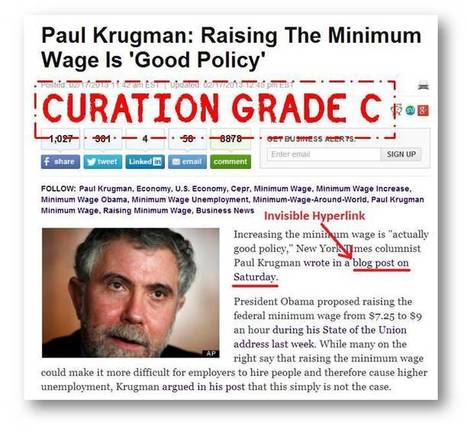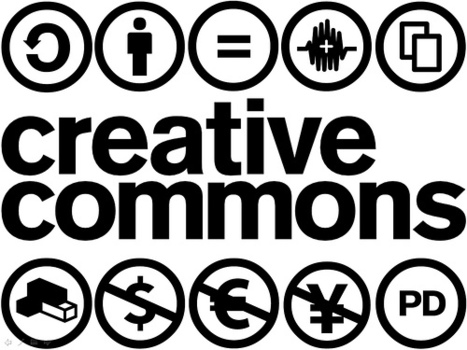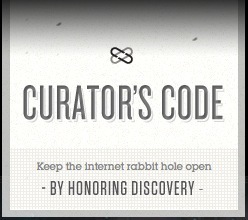Get Started for FREE
Sign up with Facebook Sign up with X
I don't have a Facebook or a X account

 Your new post is loading... Your new post is loading...
 Your new post is loading... Your new post is loading...

El código Gutenberg's comment,
August 18, 2012 2:01 PM
Thank you very much. You're very kind. I hope that readers like my work in "El código Gutenberg". And thank you for the information in your page.

nickcarman's curator insight,
February 17, 2013 5:45 PM
This is an excellent article, which lays out the groundrules for using, or citing someone else's content.

Robin Good's comment,
April 18, 2012 1:16 AM
Thank you Jonathan. Glad to be of help and inspiration to you.

Tony Gu's comment,
April 20, 2012 1:30 AM
I am really enjoying reading this article.
I found that the way Robin Good curate this article truly practice the ‘No Stealing’ rules. Thanks for sharing this with all of us. Big up! |

Andreas Kuswara's curator insight,
February 27, 2013 11:09 PM
with the increase in mash-up content, the issues of IP such as this would need our attention and commonsense. 
Media&Learning's curator insight,
February 28, 2013 3:40 AM
Features, best practices, copyright, use and examples of content curation. Basically everything it is useful to know about content curation. Plenty of useful information. Original scoop by Robin Good, Author: Pawan Deshpande of Curata Full guide: http://www.contentcurationmarketing.com/content-curation-copyright-ethics-fair-use 
Mary Dawson's curator insight,
June 21, 2013 11:39 AM
I am very aware of the fact that I am using a digital curation site to highlight external resources about images and Copyright and therefore it seems sensible to highlight some of the pitfalls of this approach. I note that the Scoop.it example does not come out of this too well!

Giuseppe Mauriello's comment,
July 20, 2012 2:43 PM
Hi Robin,
in this period I am busy, and I have no time to discover news and curate my topic. Thank you so much for your great curation!

Beth Kanter's comment,
March 11, 2012 1:01 PM
Thanks Robin for sharing and curating this article with your summary. I discovered it via Barbara Bray's collection where she had re scooped your scoop -- [and if following the curator's code added a via]. I came over here to rescoop (with a via!) because you are the original source and one of the links was broken (you corrected it and added an update) thus reminding me the importance of going to the original source. Here on scoop.it you can just follow the trail of the rescoop icon.
I am disappointed that the bookmarklet doesn't work together with the scoop.it one - but it would be great to have it integrated. Now to figure out how to rescoop it with the characters. 
Robin Good's comment,
March 11, 2012 1:12 PM
Hi Beth, thanks for your kind feedback. I was just out today for a video interview with Nancy White here in Rome, and she mentioned you as someone she likes for your ability to curate and make sense of things.
Re the integration of the curators' code icons, I have received feedback from Guillaume De Cugies of Scoop.it that he has been exchanging with Maria Popova and that he is looking with her for a way to integrate the two. For now you can simply install the Curators' Code bookmarklet and use the "via"<a href="http://www.curatorscode.org" target="_blank" style="font-family:sans-serif;text-decoration:none" >ᔥ</a> or hat tip <a href="http://www.curatorscode.org" target="_blank" style="font-family:sans-serif;text-decoration:none" >↬</a> icons by copying and pasting their code into your scoops manually. The problem, at least for me is, that the scoop.it editing window is in the same position where the Curators' Code bookmarklet is and therefore I can't see both at the same time. In any case I think it would be trivial for Scoop.it or any other tool to integrate such buttons directly into their system without having us to use two different tools for one task. 
's comment March 11, 2012 9:36 PM
Many thanks Robin for the help! Somehow I missed the article -- computer fatigue probably :) I read it earlier today and look forward to using the codes. I'm thrilled to hear that scoop.it is looking into integrating them into the platform. Thanks for keeping us updated on this new, and important twist, for curating. Cheers -- Karen
|

















Sharing because it's so important. I realized how important it was after forgetting to attribute a source to a photo. Plagiarism just plain sucks on all levels, but overlooking source attribution is bad manners at best.
Des conseils pour éviter le plagiat destinés aus journalistes comme à tous ceux qui écrivent régulièrement en ligne. Un rappel de bonnes pratiques.
Presentación en Slide publicada hace unos días por Steve Buttry que enumera todas las situaciones en las que es posible correr el riesgo de ser acusado de plagio.
La presentación es un resumen de consejos para periodistas online que tienen que lidiar a diario con la adición de enlaces de referencia, la concesión de créditos y la atribución de autoría y evitar ser acusados de plagio.
Un buen consejo que no debe tomarse a la ligera